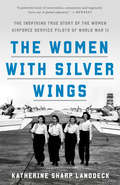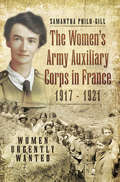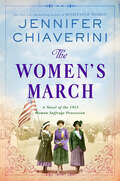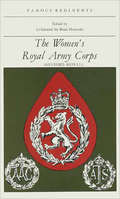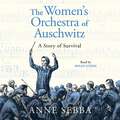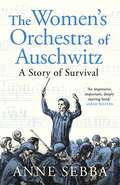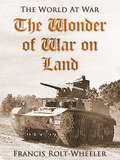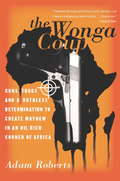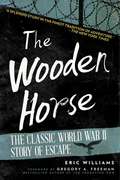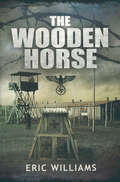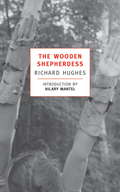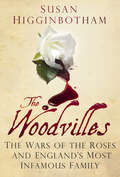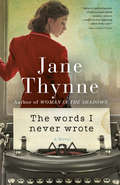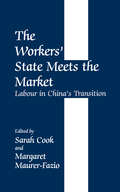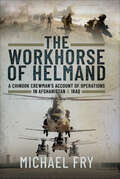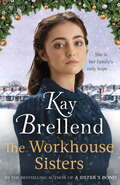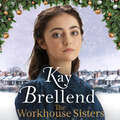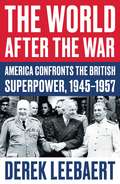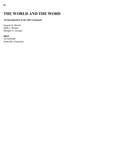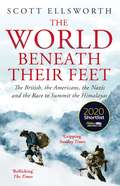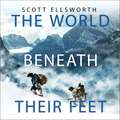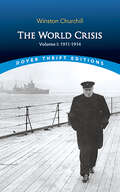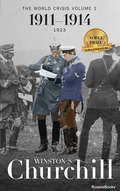- Table View
- List View
The Women with Silver Wings: The Inspiring True Story of the Women Airforce Service Pilots of World War II
by Katherine Sharp Landdeck&“With the fate of the free world hanging in the balance, women pilots went aloft to serve their nation. . . . A soaring tale in which, at long last, these daring World War II pilots gain the credit they deserve.&”—Liza Mundy, New York Times bestselling author of Code Girls When the Japanese attacked Pearl Harbor in December 1941, Cornelia Fort was already in the air. At twenty-two, Fort had escaped Nashville&’s debutante scene for a fresh start as a flight instructor in Hawaii. She and her student were in the middle of their lesson when the bombs began to fall, and they barely made it back to ground that morning. Still, when the U.S. Army Air Forces put out a call for women pilots to aid the war effort, Fort was one of the first to respond. She became one of just over 1,100 women from across the nation to make it through the Army&’s rigorous selection process and earn her silver wings. The brainchild of trailblazing pilots Nancy Love and Jacqueline Cochran, the Women Airforce Service Pilots (WASP) gave women like Fort a chance to serve their country—and to prove that women aviators were just as skilled as men. While not authorized to serve in combat, the WASP helped train male pilots for service abroad, and ferried bombers and pursuits across the country. Thirty-eight WASP would not survive the war. But even taking into account these tragic losses, Love and Cochran&’s social experiment seemed to be a resounding success—until, with the tides of war turning, Congress clipped the women&’s wings. The program was disbanded, the women sent home. But the bonds they&’d forged never failed, and over the next few decades they came together to fight for recognition as the military veterans they were—and for their place in history.
The Women's Army Auxiliary Corps in France, 1917–1921: Women Urgently Wanted
by Samantha Philo-GillIn March 1917, the first women to be enrolled into the British Army joined the newly formed Womens Army Auxiliary Corps (WAAC). The women substituted men in roles that the Army considered suitable, thereby freeing men to move up the line. The WAACs served, for example, as cooks, drivers, signallers, clerks, as well as gardeners in the military cemeteries. Due to their exemplary service, Queen Mary gave her name to the Corps in April 1918 and it became Queen Marys Army Auxiliary Corps (QMAAC). By the time the Corps was disbanded in 1921, approximately 57,000 women had served both at home and in France.This book details the establishment of the Corps and subsequently explores the experience of the WAACs who served in France. It follows the women from enrollment to the camps and workplaces overseas, through to their experiences of the Spring Offensive of 1918, the Armistice and demobilization. The final chapter reviews how the women have been remembered in art, literature, museums and memorials. Throughout the book, the author locates the women in a society at war and examines how they were viewed by the Army, the general public and the press. The author draws on a wide range of sources to provide the background and uses the oral and written testimonies of the women themselves to tell their stories. This book will be of interest to social, womens and military historians, as well as family history researchers.
The Women's March: A Novel of the 1913 Woman Suffrage Procession
by Jennifer ChiaveriniNew York Times bestselling author Jennifer Chiaverini returns with The Women’s March, an enthralling historical novel of the women’s suffrage movement inspired by three courageous women who bravely risked their lives and liberty in the fight to win the vote.Twenty-five-year-old Alice Paul returns to her native New Jersey after several years on the front lines of the suffrage movement in Great Britain. Weakened from imprisonment and hunger strikes, she is nevertheless determined to invigorate the stagnant suffrage movement in her homeland. Nine states have already granted women voting rights, but only a constitutional amendment will secure the vote for all.To inspire support for the campaign, Alice organizes a magnificent procession down Pennsylvania Avenue in Washington, DC, the day before the inauguration of President-elect Woodrow Wilson, a firm antisuffragist.Joining the march is thirty-nine-year-old New Yorker Maud Malone, librarian and advocate for women’s and workers’ rights. The daughter of Irish immigrants, Maud has acquired a reputation—and a criminal record—for interrupting politicians’ speeches with pointed questions they’d rather ignore.Civil rights activist and journalist Ida B. Wells-Barnett resolves that women of color must also be included in the march—and the proposed amendment. Born into slavery in Mississippi, Ida worries that white suffragists may exclude Black women if it serves their own interests.On March 3, 1913, the glorious march commences, but negligent police allow vast crowds of belligerent men to block the parade route—jeering, shouting threats, assaulting the marchers—endangering not only the success of the demonstration but the women’s very lives.Inspired by actual events, The Women’s March offers a fascinating account of a crucial but little-remembered moment in American history, a turning point in the struggle for women’s rights.
The Women's Royal Army Corps (Famous Regiments)
by Shelford BidwellWhen the history of the Twentieth Century is written let us hope that the few nobel ideals of our era are not entirely submerged by the scientific miracles and horrors which increasingly dominate our lives. High among such ideas must rank the recognition of women in more and more walks of life as equal partners with men, and in no area was the battle for recognition fought with greater determination then or more evident ultimate justification in the righteousness of their course then in the Women's Army Auxiliary Corps, later to become the WRAC. As Brigadier Bidwell puts it: At the heart of the question was not so much doubt about the ability or reliability of women, but an unformulated but powerful fear of the consequences of their intrusion in strength into an entity so exclusively and aggressively male as an army in the field'. He goes on to demonstrate how they managed not only to dispel that fear but but to replace it with admiration and respect which few could have dared to envisage at the outset. The Corps must be warmly congratulated upon their decision to ask Brigadier Bidwell to write their history. As an experienced military historian but nevertheless a detached observer, he brings to his task an objectivity and balance of judgement which exonerates his book from any taints of hagiography but nevertheless constitutes a record of which even the oldest regiments would be proud.
The Women’s Land Army in First World War Britain
by Bonnie WhiteBetween 1917 and 1919 women enlisted in the Women's Land Army, a national organisation with the task of increasing domestic food production. Behind the scenes organisers laboured to not only recruit an army of women workers, but to also dispel public fears that Britain's Land Girls would be defeminized and devalued by their wartime experiences.
The Women’s Orchestra of Auschwitz: A Story of Survival
by Anne Sebba'Superb and timely' KATE MOSSE'Impressive, important, deeply moving' SARAH WATERS'Brilliant' ANTHONY HOROWITZWhat role could music play in a death camp? What was the effect on those women who owed their survival to their participation in a Nazi propaganda project? And how did it feel to be forced to provide solace to the perpetrators of a genocide that claimed the lives of their family and friends? In 1943, German SS officers in charge of Auschwitz-Birkenau ordered that an orchestra should be formed among the female prisoners. Almost fifty women and girls from eleven nations were assembled to play marching music to other inmates - forced labourers who left each morning and returned, exhausted and often broken, at the end of the day - and give weekly concerts for Nazi officers. Individual members were sometimes summoned to give solo performances of an officer's favourite piece of music. It was the only entirely female orchestra in any of the Nazi prison camps and, for almost all of the musicians chosen to take part, being in the orchestra was to save their lives. In The Women's Orchestra of Auschwitz, award-winning historian Anne Sebba tells their astonishing story with sensitivity and care.
The Women’s Orchestra of Auschwitz: A Story of Survival
by Anne Sebba'Superb and timely' KATE MOSSE'Impressive, important, deeply moving' SARAH WATERS'Brilliant' ANTHONY HOROWITZWhat role could music play in a death camp? What was the effect on those women who owed their survival to their participation in a Nazi propaganda project? And how did it feel to be forced to provide solace to the perpetrators of a genocide that claimed the lives of their family and friends? In 1943, German SS officers in charge of Auschwitz-Birkenau ordered that an orchestra should be formed among the female prisoners. Almost fifty women and girls from eleven nations were assembled to play marching music to other inmates - forced labourers who left each morning and returned, exhausted and often broken, at the end of the day - and give weekly concerts for Nazi officers. Individual members were sometimes summoned to give solo performances of an officer's favourite piece of music. It was the only entirely female orchestra in any of the Nazi prison camps and, for almost all of the musicians chosen to take part, being in the orchestra was to save their lives. In The Women's Orchestra of Auschwitz, award-winning historian Anne Sebba tells their astonishing story with sensitivity and care.
The Wonder of War on Land (The World At War)
by Francis Rolt-WheelerFrancis Rolt-Wheeler (1876 - 1960) was born Francis William Wheeler in Forest Hills, England. He lived with his family, in England, until some time before 1901. He crossed the Atlantic where he became a naturalised US citizen in 1903, working as a journalist. Starting around 1906, Wheeler made a name for himself -- as Francis Rolt-Wheeler -- as a writer of books, mostly for boys, like The Boy with the United States Survey and The Boy with the US Trappers. He also published a 10 volume Science-History of the Universe, books for children with topics ranging from Aztecs to dinosaurs to Thomas Alva Edison, a series of books on aspects of the first world war, and some poetry and drama. Francis Rolt-Wheeler remained in the US until the late 1920, and his reputation as a writer of popular boy's material continued to wax through the 1920s. He was traveling globally quite a bit during this period and left the US for the Middle East, where he began his second career as an occultist. The Rolt-Wheeler handle was used by both Francis and his sister Ethel, a poet, writer, reincarnationist and Fellow of the Theosophical Society.
The Wonga Coup: Guns, Thugs, and a Ruthless Determination to Create Mayhem in an Oil-Rich Corner of Africa
by Adam RobertsEquatorial Guinea is a tiny country roughly the size of the state of Maryland. Humid, jungle covered, and rife with unpleasant diseases, natives call it Devil Island. Its president in 2004, Obiang Nguema, had been accused of cannibalism, belief in witchcraft, mass murder, billiondollar corruption, and general rule by terror. With so little to recommend it, why in March 2004 was Equatorial Guinea the target of a group of salty British, South African and Zimbabwean mercenaries, travelling on an American-registered ex-National Guard plane specially adapted for military purposes, that was originally flown to Africa by American pilots? The real motive lay deep below the ocean floor: oil. In The Dogs of War, Frederick Forsyth effectively described an attempt by mercenaries to overthrow the government of Equatorial Guinea - in 1972. And the chain of events surrounding the night of March 7, 2004, is a rare case of life imitating art-or, at least, life imitating a 1970s thriller-in almost uncanny detail. With a cast of characters worthy of a remake of Wild Geese and a plot as mazy as it was unlikely, The Wonga Coup is a tale of venality, overarching vanity and greed whose example speaks to the problems of the entire African continent.
The Wooden Horse: The Classic World War II Story of Escape (Military Classics Ser.)
by Gregory A. Freeman Eric WilliamsAn epic adventure-the most brilliant escape and evasion from the Nazis ever written.Eric Williams, a Royal Air Force bomber captain, was shot down over Germany in 1942 and imprisoned in Stalag Luft III, the infamous German POW camp. Digging an underground tunnel hidden beneath a wooden vaulting horse, he managed to escape after ten months and, accompanied by a fellow officer, made his way back to England. In this thinly fictionalized retelling, Williams relates his story in three distinct phases: the construction of a tunnel (its entrance camouflaged by the wooden vaulting horse in the exercise yard) and hiding the large quantities of sand he dug; the escape; and the journey on foot and by train to the port of Stettin, where Williams and his fellow escapee stowed away aboard a Danish ship, the Norensen.From painstakingly digging the tunnel to secretly depositing the dirt and gravel around the camp to dodging searchlights and search dogs and climbing barbed wire fences, this is an escape story hard to beat. For sheer heroism, courage, and perseverance, this classic is arguably the most ingenious POW escape of WWII. The Wooden Horse became a legend among servicemen long before its publication in 1949 and has remained one ever since.
The Wooden Horse: The Classic World War Ii Story Of Escape (Military Classics Ser.)
by Eric WilliamsIt is over fifty years since the critics of the day acclaimed The Wooden Horse as a superbly told story of the most ingenious and daring escape of the Second World War. Millions of readers agreed, and the book became a modern classic. This revised and expanded edition tells the tale. The escape itself was conceived on classical lines. The Greeks built a wooden horse and by means of it got into the city of Troy; in 1943 two British officers built a wooden horse and by means of it got out of a German prison camp. Together with a third companion, they were the only British prisoners ever to escape and reach England from this camp, though many tried. It was Stalag Luft III, designed especially to hold the Germans' most prized captives – Allied aircrew – and considered to be escape-proof. The break from the camp itself is only part of the story. Once outside the wire the escapers were still faced with the problem of getting out of Germany. Fugitives in the midst of a watchful enemy population, they had many close shaves when disaster threatened to overwhelm them – adventures which the reader shares to the full. The fantastic nature of this enterprise, the patience, determination and endurance, above all the steel nerve it demanded from an undernourished physique, are rendered the more impressive by the manner of the telling. The characters are so surely drawn that they could not but be real. Throughout the book runs a vein of humour which alone made those days bearable. The warmth of human companionship born of privation, fear and a common purpose is vividly portrayed.
The Wooden Shepherdess
by Hilary Mantel Richard HughesThe Wooden Shepherdess is the sequel to The Fox in the Attic, and the second volume of Richard Hughes's monumental historical fiction, "The Human Predicament." It opens with Hughes's hero Augustine in prohibition era America, where he is a bemused onlooker and an increasingly fascinated participant in a country intoxicated with sex, violence, and booze. In brilliant cinematic style, the book then moves to Germany, where the Nazi Party is gradually gaining in power; to the slums, mining towns, parliamentary back rooms, and great houses of a Britain teetering on the verge of class war; and to the wilds of the Atlas Mountains of Morocco. The novel ends with a terrifying account of the Night of the Long Knives, as Hitler ruthlessly secures his hold upon Germany. This new edition of the The Wooden Shepherdess concludes with the twelve chapters that Hughes completed of the planned third volume of "The Human Predicament," here published for the first time in America.
The Woodvilles: The Wars of the Roses and England's Most Infamous Family
by Susan HigginbothamIn 1464, the most eligible bachelor in England, Edward IV, stunned the nation by revealing his secret marriage to Elizabeth Woodville, a beautiful, impoverished widow whose father and brother Edward himself had once ridiculed as upstarts. Edward’s controversial match brought his queen’s large family to court and into the thick of the Wars of the Roses. This is the story of the family whose fates would be inextricably intertwined with the fall of the Plantagenets and the rise of the Tudors: Richard, the squire whose marriage to a duchess would one day cost him his head; Jacquetta, mother to the queen and accused witch; Elizabeth, the commoner whose royal destiny would cost her three of her sons; Anthony, the scholar and jouster who was one of Richard III’s first victims; and Edward, whose military exploits would win him the admiration of Ferdinand and Isabella.
The Words I Never Wrote: A Novel
by Jane ThynneA chance discovery inside a vintage typewriter case reveals the gripping story of two sisters on opposite sides of World War II in this captivating novel for readers of Lilac Girls and The Women in the Castle. New York, present day: On a whim, Juno Lambert buys a 1931 Underwood typewriter that once belonged to celebrated journalist Cordelia Capel. Within its case she discovers an unfinished novel, igniting a transatlantic journey to fill the gaps in the story of Cordelia and her sister and the secret that lies between them. Europe, 1936: Cordelia&’s socialite sister Irene marries a German industrialist who whisks her away to Berlin. Cordelia, feistier and more intellectual than Irene, gets a job at a newspaper in Paris, pursuing the journalism career she cherishes. As politics begin to boil in Europe, the sisters exchange letters and Cordelia discovers that Irene&’s husband is a Nazi sympathizer. With increasing desperation, Cordelia writes to her beloved sister, but as life in Nazi Germany darkens, Irene no longer dares admit what her existence is truly like. Knowing that their letters cannot tell the whole story, Cordelia decides to fill in the blanks by sitting down with her Underwood and writing the truth. When Juno reads the unfinished novel, she resolves to uncover the secret that continued to divide the sisters amid the turmoil of love, espionage, and war. In this vivid portrait of Nazi Berlin, from its high society to its devastating fall, Jane Thynne examines the truths we sometimes dare not tell ourselves.Advance praise for The Words I Never Wrote&“In sumptuous prose, Jane Thynne limns the lives of two sisters ripped apart by the moral choices they made in a time of war. Dramatic, fast-paced, and emotional, The Words I Never Wrote puts the interior details of women&’s lives in stark relief against the dramatic backdrop of Europe in World War II, helping readers understand the difficult choices that women made.&”—Elizabeth Letts, author of The Perfect Horse: The Daring U.S. Mission to Rescue the Priceless Stallions Kidnapped by the Nazis &“Haunting, taut, and compelling, this portrait of two upper-class British sisters divided by World War II is a kaleidoscopic story of love and betrayal whose characters are never quite what they seem. It will capture your attention immediately and keep you thinking for a long time to come.&”—Lynne Olson, author of Madame Fourcade&’s Secret War
The Workers' State Meets the Market: Labour in China's Transition
by Sarah Cook Margaret Maurer-FazioAmong the most dramatic changes to affect China in the 1990s is the upsurge in labour mobility and the emergence of a market-driven system of labour allocation, changes which profoundly affect the working environment and livelihoods of the Chinese people. Papers in this collection draw on a wide variety of data sources to analyse key elements of this transformation.
The Workhorse of Helmand: A Chinook Crewman's Account of Operations in Afghanistan & Iraq
by Michael FryAs a RAF Chinook crewman, Mick Fry’s exposure to Afghanistan spanned over 10 years and countless deployments, from watching 9/11 unfold in Australia, leaving the deck of HMS Ocean off the coast of Pakistan under the cover of darkness all the way through numerous fighting seasons and the chaos of Helmand Province. The Chinook helicopter was the workhorse of the British Military operations in Afghanistan, and the crews from RAF Odiham were confronted by their own mortality on an almost daily basis as they worked tirelessly and skillfully to support the troops on the ground. Whether it was taking part in air assault missions against a determined enemy, or extracting casualties from the battlefield under fire, and in a life or death race against time, Mick witnessed both the best and worst of humanity on a daily basis. His story is both gripping and confronting. It takes the reader on a journey through combat operations in both Iraq and Afghanistan. The Author paints a gritty picture of repeated operational deployments, balancing harrowing scenes and the ever present threat of death with the humor and camaraderie of comrades and the exhilaration of surviving Taliban RPG’s and AK47 fire.
The Workhouse Sisters: The absolutely gripping and heartbreaking story of one woman’s journey to save her family (Workhouse to War)
by Kay BrellendAfter escaping the grip of the workhouse, Lily has kept her fiancé's business afloat while he is away fighting on the Western Front. Still battling on, she's now doing her bit for her country as an auxiliary nurse - but one thing above all else continues to weigh heavily on her heart: her long-lost sister.Born just before her mother died, the scandal was hushed-up and the baby spirited away. But now, at last, there is hope Lily could find her little sister for she has a clue to go on: the name of the notorious baby farmer who bought the child all those years ago. Mrs Jolley.Using all her pluck, and with the help of her two friends Margie and Fanny, Lily will do anything in her power to find her little sister and save her from the dark streets of London.With Winter drawing in, and the war with no end in sight, will she be able to bring her family together?
The Workhouse Sisters: The absolutely gripping and heartbreaking story of one woman’s journey to save her family (Workhouse to War)
by Kay BrellendAfter escaping the grip of the workhouse, Lily has kept her fiancé's business afloat while he is away fighting on the Western Front. Still battling on, she's now doing her bit for her country as an auxiliary nurse - but one thing above all else continues to weigh heavily on her heart: her long-lost sister.Born just before her mother died, the scandal was hushed-up and the baby spirited away. But now, at last, there is hope Lily could find her little sister for she has a clue to go on: the name of the notorious baby farmer who bought the child all those years ago. Mrs Jolley.Using all her pluck, and with the help of her two friends Margie and Fanny, Lily will do anything in her power to find her little sister and save her from the dark streets of London.With Winter drawing in, and the war with no end in sight, will she be able to bring her family together?
The Workhouse Sisters: The absolutely gripping and heartbreaking story of one woman’s journey to save her family (Workhouse to War)
by Kay BrellendAfter escaping the grip of the workhouse, Lily has kept her fiancé's business afloat while he is away fighting on the Western Front. Still battling on, she's now doing her bit for her country as an auxiliary nurse - but one thing above all else continues to weigh heavily on her heart: her long-lost sister.Born just before her mother died, the scandal was hushed-up and the baby spirited away. But now, at last, there is hope Lily could find her little sister for she has a clue to go on: the name of the notorious baby farmer who bought the child all those years ago. Mrs Jolley.Using all her pluck, and with the help of her two friends Margie and Fanny, Lily will do anything in her power to find her little sister and save her from the dark streets of London.With Winter drawing in, and the war with no end in sight, will she be able to bring her family together?
The World After the War: America Confronts the British Superpower, 1945–1957
by Derek LeebaertOne of the great myths of the twentieth century is that after the Second World War Britain simply relinquished its power and America quickly embraced its worldwide political and military commitments. Instead the two allies improvised an uneasy, shifting partnership for twelve long years while most of western Europe lay in turmoil and Russia grew more aggressive. But in 1957 Washington issued a &‘declaration of independence&’ from British authority. It was then that everything changed, and America assumed leadership of the new world order just taking shape. Derek Leebaert spins a riveting global narrative of Britain as the original superpower and shows why the Americans kept believing it to be indispensable. It&’s the story of secret ties, diplomatic quarrels and military interventions that casts political giants Churchill, Truman, Eisenhower and Johnson in a new light. In a volatile world of decolonisation, a uniting Europe and the Suez Crisis, shrewd men in London were leveraging the empire&’s long-established resources and influence to maintain their grip on power. The enduring notion of a special relationship, rising tensions with Russia and China, and the sources of much of the world&’s turmoil can&’t be understood without knowing what really occurred.
The World And The Word: An Introduction To The Old Testament
by Eugene H. Merrill Mark Rooker Michael A. GrisantiThe World and the Word is a fresh introduction to the Old Testament driven largely by the fact that so much Christian preaching and teaching today increasingly ignores what is eighty percent of the Bible. Authors Eugene Merrill, Mark Rooker, and Michael Grisanti work through the world and text of the Old Testament always making three major points: • The Old Testament is a rich source of theology and doctrine that is presupposed by the New Testament. Without it, Christian theology would be seriously deficient. • Mastery of the Old Testament is crucial to an understanding of the New Testament. • The Old Testament offers, by teaching and example, practical principles of belief and behavior for contemporary times. Who God was and what He did then can be replicated in the lives of men and women today.
The World Beneath Their Feet: The British, the Americans, the Nazis and the Mountaineering Race to Summit the Himalayas
by Scott EllsworthLonglisted for the 2020 William Hill Sports Book of the Year'A gripping history' THE ECONOMIST 'The World Beneath Their Feet contains plenty of rollicking stories' THE TIMES'Gripping' THE SUNDAY TIMES'So far as adventure stories go, this book is tops.' Winston Groom, author of Forrest Gump'[Ellsworth] recasts the era as a great Himalayan race...[and] it works brilliantly...his account of the 1953 ascent of Everest...feels unusually fresh' THE SUNDAY TIMES 'Like if Jon Krakauer's Into Thin Air met Lauren Hillenbrand's Unbroken ... an inviting and engrossing read' SPORTS ILLUSTRATEDOne of the most compelling international dramas of the 20th century and an unforgettable saga of survival, technological innovation, and breathtaking human physical achievement-all set against the backdrop of a world headed toward war.While tension steadily rose between European powers in the 1930s, a different kind of battle was raging across the Himalayas. Contingents from Great Britain, Nazi Germany, and the United States had set up rival camps at the base of the mountains, all hoping to become recognized as the fastest, strongest, and bravest climbers in the world.Carried on across nearly the entire sweep of the Himalayas, this contest involved not only the greatest mountain climbers of the era, but statesmen and millionaires, world-class athletes and bona fide eccentrics, scientists and generals, obscure villagers and national heroes. Centered in the 1930s, with one brief, shining postwar coda, the contest was a struggle between hidebound traditionalists and unknown innovators, one that featured new techniques and equipment, unbelievable courage and physical achievement, and unparalleled valor. And death. One Himalayan peak alone, Nanga Parbat in Kashmir, claimed twenty-five lives in less than three years.Climbing the Himalayas was the Greatest Generation's moonshot--one shrouded in the onset of war, interrupted by it, and then fully accomplished. A gritty, fascinating history that promises to enrapture fans of Hampton Side, Jon Krakauer, and Laura Hillenbrand, The World Beneath Their Feet brings this forgotten story back to life.
The World Beneath Their Feet: The British, the Americans, the Nazis and the Mountaineering Race to Summit the Himalayas
by Scott EllsworthThe stories of the extraordinary men and women - the athletes, aristocrats, opportunists and oddballs - who launched the race to the roof of the world.From 1931 to 1953, there was a race like no other. It was a race to the top of the world-a race primarily between Great Britain, Nazi Germany, and the United States.Carried on across nearly the entire sweep of the Himalayas, it involved not only the greatest mountain climbers of the era, but statesmen and millionaires, world-class athletes and bona fide eccentrics, scientists and generals, obscure villagers and national heroes. Centred in the 1930s, with one brief, shining postwar coda, the contest was a struggle between hidebound traditionalists and unknown innovators, one that featured new techniques and equipment, unbelievable courage and physical achievement, and unparalleled derring-do. And death. One Himalayan peak alone, Nanga Parbat in Kashmir, claimed twenty-five lives in less than three years. Fuelled by deep national needs, the great Himalayan race captured the attention of the world. British superiority, German innovation, American determination and the wonder of Sherpas dominated the newsreels, radio broadcasts, books and magazines of the age. The World Beneath Their Feet will bring this forgotten story back to life. It will resurrect what was, in fact, one of the most compelling international dramas of the 1930s, a saga of survival, technology, and some of the most breathtaking human physical achievements, and athletes, ever known, all set against the backdrop of a world headed toward war.(P) 2019 Hodder & Stoughton Ltd
The World Crisis, Volume I: 1911-1914 (Dover Thrift Editions)
by Winston ChurchillBest known as the Prime Minister who guided Britain through World War II, Winston Churchill also played an active role in the preceding war, during which he served as his country's First Lord of the Admiralty and the leader of its aerial defense. After masterminding the disastrous Gallipoli campaign, he resigned from the government and sought to rehabilitate his reputation by serving with the army on the Western Front. Before and after World War I, Churchill wrote several books that remain popular with students and historians. Written with his customary flair and enriched by his firsthand knowledge of events, Churchill's The World Crisis series remains the greatest history of World War I. This unabridged first volume vividly recounts the status of the world's nations at the war's outbreak, It traces the international tensions over the Balkan states that triggered the conflict as well as the arms race between the British and German navies.
The World Crisis: 1911-1914 (Winston S. Churchill World Crisis Collection #1)
by Winston S. ChurchillThe causes of the Great War are examined in this first volume of the series that is &“essential reading, as fresh and compelling as ever&” (Jon Meacham, bestselling author of Franklin and Winston). An absorbing history of the outbreak of World War I from a true insider&’s point of view, the first volume of Winston S. Churchill&’s five-volume The World Crisis is unsurpassed as both a historical and personal account of the earth-shaking events leading up to WWI. Beginning in 1911, when Churchill was First Lord of the Admiralty, this report is based on thousands of his personal letters and memos. Churchill&’s epic series opens with a chilling description of the Agadir Crisis, and provides an in-depth account of naval clashes in the Dardanelles, one of Churchill&’s major military failures. It takes readers from the fierce bloodshed of the Gallipoli campaign to the tide-turning battles of Jutland and Verdun—as well as the United States&’ entry into the combat theatre. Written in powerful prose by a great leader who would also go on to receive a Nobel Prize in Literature, The World Crisis, 1911–1914 provides a perspective you won&’t find anywhere else: a dynamic insider&’s account of events that would shape the outcome of modern history. &“Whether as a statesman or an author, Churchill was a giant; and The World Crisis towers over most other books about the Great War.&” —David Fromkin, author of A Peace to End All Peace
